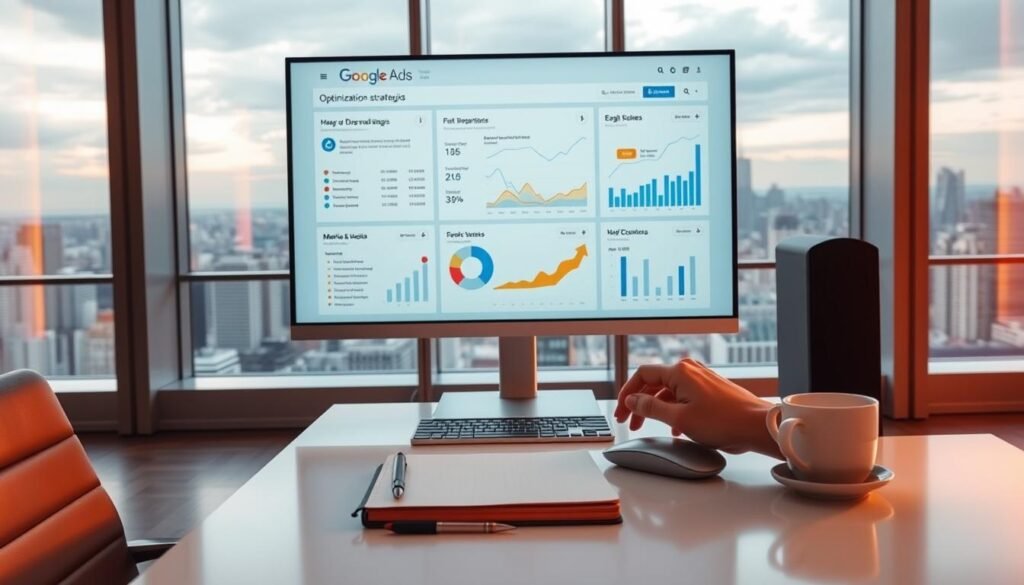Understanding google ads pricing is key for businesses to plan their online marketing budget. The cost of google ads changes based on industry, location, and where ads are placed. We’ll explore how google ads pricing affects your online marketing strategy.

Knowing about google ads pricing helps businesses create ads that work. Whether you’re experienced or new, understanding this is vital for using your budget wisely.
Introduction to Google Ads
Google Ads is a great way for businesses to find their audience and get more sales. It uses a cost-per-click model, letting businesses control their spending. But, figuring out google ads pricing can be tricky. It’s important to know the cost to make smart choices.
Key Takeaways
- Understanding google ads pricing is crucial for businesses to make informed decisions about their advertising budget.
- The cost of google ads can vary greatly depending on several factors, including industry, location, and ad placement.
- Grasping the concepts of google ads pricing and the cost of google ads can help businesses create effective advertising campaigns.
- Google Ads is a powerful tool for businesses to reach their target audience and drive conversions.
- Navigating the world of google ads pricing can be complex, and it’s essential to have a clear understanding of the cost of google ads.
- By controlling their advertising spend, businesses can maximize their return on investment with google ads.
Understanding the Basics of Google Ads Pricing
To get the most out of your Google Ads campaign, it’s key to know the basics of pricing. You need to understand the pay-per-click (PPC) model and how it impacts your cost per click. The PPC model means you only pay when someone clicks on your ad. This way, you control your budget and only pay for ads that bring in traffic.
Google Ads offers different campaign types, each with its own pricing. For instance, you can run a search campaign for users searching for specific keywords. Or, you can use a display campaign for users browsing relevant websites. Knowing these options helps you manage your budget better and get the most from your ads.
Key Pricing Metrics
There are important pricing metrics to know in Google Ads. These include cost per click (CPC), cost per conversion (CPA), and return on ad spend (ROAS). CPC is the cost per ad click, CPA is the cost per conversion, and ROAS is the revenue from ads compared to their cost. Understanding these helps you optimize your ad spending and ensure a good return on investment.
By grasping the basics of Google Ads pricing and optimizing your campaigns, you can make ads that drive traffic and conversions. Keep an eye on your cost per click and adjust your budget to maximize your ad performance.
Average Cost Per Click Across Different Industries
Google Ads costs can change a lot based on the industry, who you’re trying to reach, and where your ads are shown. Knowing the average cost per click (CPC) in various industries helps you compare your campaigns. This way, you can work on getting a better return on investment (ROI). The google ads cost per conversion is very important, as it affects your google ads roi.
Here are some key factors that influence CPC:
- Industry competition: Highly competitive industries tend to have higher CPCs.
- Target audience: The cost of targeting specific demographics, interests, or behaviors can vary significantly.
- Ad placement: The cost of ads on Google Search, Display Network, or YouTube can differ.
To improve your CPC and google ads roi, create high-quality ad campaigns. Target specific audiences and ad placements. By knowing the average CPC in different industries, you can make better choices about your Google Ads budget and bidding. This can lead to more conversions and revenue for your business.
Factors That Influence How Much It Costs to Run Ads on Google
Running ads on Google can cost differently based on several factors. Knowing these factors is key to a successful ad campaign. The cost is affected by the ad’s quality, the competition level, and the targeting options.
Good google ads optimization can cut costs and boost ad performance. A high-quality ad with a good quality score can lead to lower google ads management fees and better placement.
Other cost factors include the industry’s competition level. More competitive industries usually mean higher ad costs. Also, targeting specific areas or running ads in peak seasons can increase costs.
To lower ad costs, consider these tips:
- Improve ad quality and relevance to increase quality score
- Target specific geographic locations to reduce competition
- Run ads during off-peak seasons to reduce costs
By understanding these factors and optimizing ad campaigns, businesses can lower their google ads management fees and see better returns.
Setting Your Initial Google Ads Budget
When setting your google ads budget, think about your marketing goals, who you want to reach, and what others in your field spend. A smart budget helps you use your money well and get a good return. First, figure out your average google ads cost per click and choose a daily budget that fits your goals.
It’s wise to start small and grow your budget as you learn more. This way, you won’t spend too much and make sure your ads reach the right people. Use these points to help decide how much to spend:
- Marketing goals: What do you want to achieve with your Google Ads campaign?
- Target audience: Who are your ideal customers, and what are their search habits?
- Industry benchmarks: What are the average google ads cost per click and conversion rates in your industry?
By thinking about these things and setting a realistic google ads budget, you can run a Google Ads campaign that works for your business. Always check how your ads are doing and change your budget if needed. This way, you’ll make sure you’re getting the most out of your investment.

Hidden Costs and Fees to Consider
When you run Google Ads, it’s key to think about hidden costs and fees. These can quickly add up, impacting your investment return. A big hidden cost is google ads management fees, which can be 10% to 20% of your ad spend.
There are also google ads optimization costs, like tools and software, and agency fees. These can boost your ad performance but also raise your costs. Here are some costs to watch out for:
- Management fees: 10% to 20% of total ad spend
- Testing and optimization expenses: $500 to $2,000 per month
- Tools and software investments: $100 to $500 per month
- Agency costs: $1,000 to $5,000 per month
To cut down on these costs, team up with a trusted agency or consultant. They can optimize your Google Ads and save you money. Knowing these hidden costs helps you budget better and get a better return on your investment.
Strategies to Reduce Your Google Ads Spend
To get the most out of your google ads roi, you need to cut down on your Google Ads costs. Start by making your ad targeting better. This means picking the right keywords, focusing on specific areas, and targeting certain audiences.
Also, make sure your ads are relevant and appealing. High-quality ads lead to more clicks and sales. Use catchy ad copy, eye-catching visuals, and landing pages that match your ads.
Another smart move is to use smart bidding strategies. This way, you pay only what you need to for ad clicks. Options include cost-per-click (CPC), cost-per-thousand impressions (CPM), and return on ad spend (ROAS) bidding.

By using these tactics, you can lower your Google Ads costs and boost your google ads roi. Always keep an eye on your ad campaigns and make adjustments as needed for the best results.
Measuring Return on Ad Spend (ROAS)
To make your Google Ads campaigns better, you need to track your return on ad spend (ROAS). This metric shows how much money your ads make compared to what they cost. By looking at your google ads roi, you can make smart choices to boost your campaigns and cut down on costs.
Tracking Key Performance Indicators
Important KPIs to watch include conversion rate, cost per conversion, and return on ad spend. These numbers give you insights into how well your ads are doing. They help you spot where you can do better. By keeping an eye on these KPIs, you can tweak your ads to get a higher ROAS.
Setting Realistic ROAS Goals
It’s key to set realistic ROAS goals for your Google Ads campaigns. Your goals should match your business aims, industry standards, and past campaign results. By aiming for reachable ROAS goals, you can guide your campaigns to better performance and lower costs. Here are some tips for setting good ROAS goals:
- Analyze your past campaign data
- Look into industry benchmarks
- Get advice from Google Ads experts
Common Pricing Mistakes to Avoid
Managing a google ads budget well means knowing common mistakes. One big error is setting the wrong budget amount. This can cause you to spend too much or too little. To fix this, keep an eye on your google ads management fees and adjust them to meet your campaign’s goals.
A good google ads budget considers many things. These include who you’re targeting, where your ads will show, and how much you’re willing to bid. Effective budget allocation is key to getting a good return on investment (ROI). Here are some tips to avoid budget mistakes:
- Set clear campaign goals and objectives
- Monitor ad performance regularly
- Adjust the google ads management fees as needed
By avoiding common pricing errors and managing your google ads budget well, businesses can do better. Always check and tweak your google ads management fees to match your campaign’s goals.
Best Practices for Budget Management
Managing your google ads budget well is key to getting a good return on your ad spend (ROAS). To do this, you need to plan your budget wisely and keep an eye on how your ads are doing. This means setting goals, tracking important metrics, and making choices based on data.
Here are some top tips for improving your google ads:
- Set a daily budget to keep costs in check
- Use bid strategies to get the best ad placement and cost
- Watch how your ads are doing and tweak them when needed
- Use google ads tools to track and boost ad performance
By sticking to these tips and checking your google ads budget often, you can make sure your ads are reaching the right people. This will help drive more conversions.
Conclusion: Making Google Ads Work Within Your Budget
Managing your Google Ads budget well is key to getting the most out of your marketing. Knowing how quality score, competition, and location affect prices helps you spend wisely. Keep a close eye on your google ads cost per click and other google ads pricing to find ways to do better.
It’s important to have a smart and data-based plan for Google Ads. Begin with a budget you can handle, try different bidding methods, and always update your ads based on how they’re doing. With careful planning, optimization, and budgeting, Google Ads can fit well within your budget and help your business grow steadily.
FAQ
What is the Pay-Per-Click (PPC) model in Google Ads?
The Pay-Per-Click (PPC) model means you only pay when someone clicks on your ad. This way, businesses can focus on specific keywords and audiences. They also get to control how much they spend.
What are the different types of Google Ad campaigns?
Google Ads has many campaign types. You can choose from Search, Display, Video, Shopping, and App campaigns. Each type has its own way of targeting and pricing.
What are the key pricing metrics in Google Ads?
In Google Ads, the main pricing metrics are Cost-Per-Click (CPC), Cost-Per-Acquisition (CPA), and Return on Ad Spend (ROAS. These help businesses see how well their ads are doing and if they’re making money.
How does Quality Score impact ad costs in Google Ads?
Quality Score is important in Google Ads. It measures how good your ad and landing page are. Ads with high Quality Scores usually cost less to run.
How does competition level in your industry affect Google Ads costs?
The competition in your industry can really affect your Google Ads costs. If many advertisers are bidding on the same keywords, costs tend to go up.
What are some hidden costs and fees to consider when running Google Ads?
There are hidden costs and fees to think about. These include management fees from agencies, costs for testing and improving ads, and money for tools and software to manage your campaigns.
What are some common pricing mistakes to avoid in Google Ads?
Some common mistakes include spending too much on certain campaigns and not adjusting bids wisely. Also, setting unrealistic bid targets can be a problem.
How can businesses measure the return on investment (ROI) from their Google Ads campaigns?
To measure ROI, track important metrics like conversion rate, cost per conversion, and return on ad spend (ROAS). These help you see if your ads are profitable.
